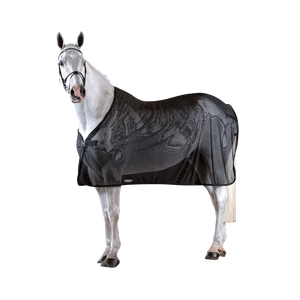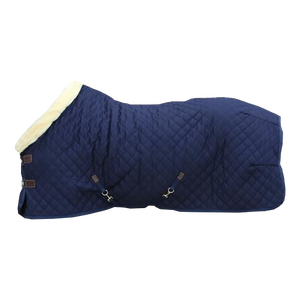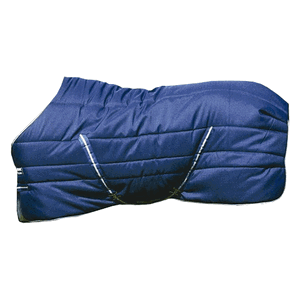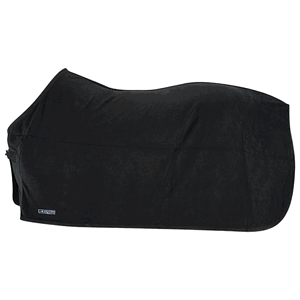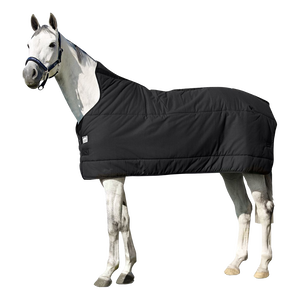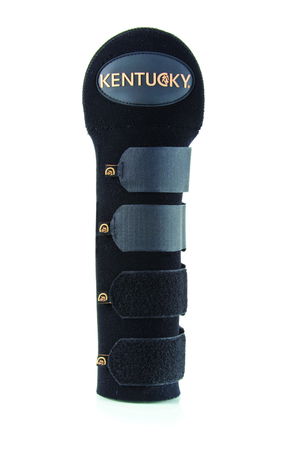Horse Sheets and -Blankets
(1390)Frequently asked questions about Horse Blankets
The right time to cover the horse is controversial. Some riders do not blanket the horse at all, arguing that the winter coat provides sufficient protection from the cold. On the other hand, there are horses who sweat excessively in winter due to the increased work and are therefore shorn. In the latter case, there is no way around a blanket. Other owners try to cover the horse early in order to prevent the horse from shedding excessive fur. To achieve this, you start covering the animal already from temperatures around the 10°C with an unlined blanket. Depending on the weather, the thickness of the blanket should then be increased as the temperature drops.
Many factors determine the timing and type of blanket a horse needs. The most important factor clearly is the temperature, however, this always depends on the type of husbandry, the state of health, the suitability as well as the age of the horse. For example, foals born early, as well as old and sick horses, need to be covered earlier and thicker than their young, vital counterparts. The reason for this is that they are less able to regulate their own thermal balance. Temporary husbandry conditions also play a role. If the animal stands outside or in a draft, it must be covered thicker than if it stands in a warmer stable. In the case of sport horses, it can happen that their backs become more sensitive over the winter. It is then necessary to keep the back and kidney area warm. Owners are therefore challenged to find the right approach through experience and testing.
Shorn horses need a much thicker blanket than their unshorn counterparts at the same temperatures, because the removal of the coat takes away the possibility of thermoregulation. The blanket must therefore fulfil the function of keeping the horse from getting cold. It is therefore necessary to provide a thick filling and to regularly check the temperature under the blanket so that it can be lightened or thickened if necessary. Shorn horses often have a very sensitive coat, which is why the blankets quickly start to chafe. To prevent this, a blanket with soft transitions - e.g. imitation fur on the chest area - should be used.
The necessary blanket size is measured from the withers to the base of the tail. The blanket should fit perfectly at both points, which means that it should neither protrude nor leave any space. One possibility is to put on a tape measure and measure the length of the back. However, young horses in particular are likely to be very suspicious of such a procedure, which is why another option is recommended. If the horse is new to the stable, but has already worn a suitable blanket in its life, it is worth asking the previous owner. Alternatively, you could borrow a blanket size from stable mates and put it on briefly to try it out. The absolute standard size for most large horses is 145 cm. If this is too short or too long, you can go back to the next size - in this case 135 cm or 155 cm - until you find the perfect size.
Horse blankets are worn all day long over the course of several months. Thus, when sleeping in hay, rolling in mud or dirt, as well as dust and dirt on the horse's skin, dirt collects in the fabric of the blanket. For this reason it is necessary to wash the blankets regularly. If a washing machine with sufficient capacity is available, the blanket can be washed at 30°C and then hung up to dry in a warm, heated room. If the blankets are taken down for the last time in spring, they should all be washed thoroughly before being stored away. This way, everything will be neatly ready for the next winter and any shortages can be exposed, with some blankets needing to be renewed or replaced.
The following figures are only guidelines and should be checked and adjusted individually depending on the type of husbandry, needs and suitability of the horse. In the transitional period, that is, when the temperatures fall permanently below 10 °C, you can start with an unlined 0 gram blanket. If the temperature drops permanently below 0°C, an unshorn horse can be covered with 50 or 100 grams. Shorn horses should be covered with about another 100 g at these temperatures. If the temperatures become even colder and drop below -5°C, you can increase the weight to 200 g. At very cold temperatures of -10 °C and above, an unshorn horse can also be covered with 300 g. Shorn horses should be covered with about 400 g at such temperatures. The particularly heavy blankets (300 and 400 g) are usually only used for shorn horses under normal weather conditions in Germany. In the meantime, however, many manufacturers offer fillings that lie between the above-mentioned values. This guarantees that every horse wears a blanket that is sufficiently warm but not too thick.
A horse blanket should be flush at the withers as well as at the base of the tail. In the chest area, make sure that the neckline is not too large, but also not too tight. If the neckline is too large, the blanket slides backwards in movement and loses fit and comfort. However, if the neckline is too small, the horse's neck and chest area will be constricted, which not only strains the closures of the blanket but also causes chafing and discomfort for the horse.
Depending on where the horse is kept, a stable blanket or an outdoor blanket is suitable. It should be kept in mind that a horse kept in a stable can just as well wear an outdoor blanket, but a horse that lives outside all year round or at least completely outside during the day will inevitably need an outdoor blanket. An exception to this rule are horses that are kept outside all year round and are only rarely ridden. This type of blanket is usually water-repellent and has a movement fold as well as a particularly firm fit to provide the horse with greater freedom even when moving.
If you want to clean your blankets very often or want to be on the safe side, you should own every blanket with the same filling in duplicate. Especially if the horse stays outside in the rain or snow, the blanket may become soaked and needs to be changed. If you generally decide to blanket your horse, it makes sense to buy a 0 g, 100 g and 200 g blanket. If you want to shear your horse, you should also have a 300 g blanket. In addition, there are sweat blankets, which should also be stocked in duplicate due to their high washing requirement, walker blankets with different fillings for owners who have a walker or a treadmill at their disposal and - not to be forgotten - fly blankets, which can provide relief from annoying black flies in the summer.
For the transitional periods, an unlined outdoor blanket or rain blanket is suitable. Horses spend more time outdoors in spring or autumn and can be surprised by a rain shower. To prevent the blanket from getting soaked, it should be wind- and water-repellent to protect the horse's sensitive back from moisture.
Since even in the depths of winter temperatures can vary greatly, you should always make sure that the blanket is adequately lined. Before and after horse riding, sweat blankets are needed, as they retain the warmth of the stable blanket before riding and transport sweat away to the outside after riding without letting the horse cool down. During the riding, kidney blankets that are attached to or under the saddle are suitable to keep the kidney area warm during the work session. If you own a treadmill or a walker, you will inevitably need a walker blanket. These are cut out at the shoulder to create maximum freedom of movement.
It is difficult to give a general answer to this question, as horses have different needs regarding blankets depending on their husbandry, their suitability or even their age. Even within one type of husbandry, such as stalls, the temperature can vary greatly in relation to the filling of the blanket. Depending on the construction and location, as well as the orientation of the stable, warmer or colder temperatures occur inside compared to outside. However, it can be assumed that a 100 g blanket is suitable for an unshorn horse at temperatures of around 0°C. If the temperature rises above 5°C, however, the blanket can be used as a protective cover for the horse. However, if the temperature rises above 5°C or falls below -5°C, the blanket should be thinner or thicker. For shorn horses, a 100 g blanket is often only sufficient for temperatures above the 0 °C mark. If the temperature drops below freezing, a shorn horse should be covered with a thicker blanket at an early stage. For horses that stand outside, the above-mentioned temperature guidelines can vary quickly, as the sensation of warmth is more dependent on the weather conditions. Thus, if the temperature remains the same but the weather conditions vary, a thinner or thicker blanket filling may be needed.
Blanket fillings around 300 g are often only used for clipped horses. However, this cannot be generalised, as unshorn horses can also wear a 300 g blanket at very cold temperatures from about -15°C onwards. Shorn horses can be covered with a 300 g blanket from about -5°C, depending on where they are kept, what kind of shearing they have and their age. However, you should check your choice of blanket regularly by checking the temperature under the blanket and paying attention to the horse's general condition. Blanketing too warm can be just as harmful as blanketing too thin, so if in doubt, it is advisable to seek help from an experienced and competent person.
Denier is a measurement that indicates the weight of a thread per 9000 m. Thus, 1 denier means that the thread weighs 1 g / 9000 m. This indicates that the fine thread is not too tear-resistant. Since horse blankets are worn around the clock, they must be robust. A high denier value is therefore obligatory, because in principle, the higher the denier value, the more durable the blanket. In addition, you should make sure that the blanket is made of nylon, as this material is almost indestructible in combination with a very high denier value.
Rain or outdoor blankets are impregnated by the manufacturer and are water-repellent. However, after longer use and repeated washing, the first layer may gradually wear off. To maintain the functionality of the blanket, the outside of the blanket should be sprayed with 2-3 layers of impregnation spray after washing. It is important to use a waterproofing spray that is not harmful to health, otherwise allergic reactions or irritation may occur. Once the spray has been applied, the layer should be allowed to air dry before it is used again. It is also important to note that not all blankets may be impregnated, so it is always worth taking a quick look at the manufacturer's instructions.
If the temperature rises above 10°C again, the blanket can be removed. In stables where it gets warm quickly, you should pay attention to the indoor temperature in advance and react accordingly. Caution is also advised in stables where temperatures are colder than outside. In general, you should always pay attention to your own horse, check the temperatures under the blanket regularly and remove the blanket based on factors such as temperature, age, shearing or the needs of the respective horse.

